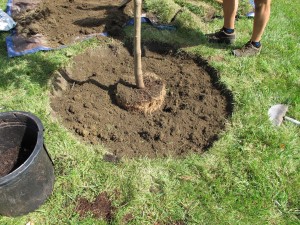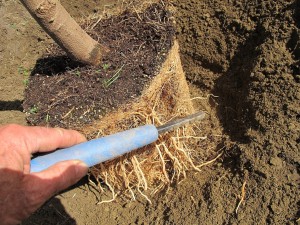Planting Trees
Fall is hard upon us, or at least here, in Cornish Flat. I know I should “toughen up” and ignore the cold, but I admit it here: I had my first fire in the wood stove recently. It felt great on a raw, rainy night. “Real” New Englanders never admit to turning on the heat or starting a fire until Halloween or later. Not me. And I’m looking at fall chores outside, too. Chief among them is planting trees and shrubs.
There is disagreement among experts as to the best time to plant trees. Some like spring, saying roots have a longer time to get established before winter. Other say no, if you skip a week or two of watering in the heat of August, you can damage roots or even kill a tree. Fall is safer, they say, because the weather is cooler and often rainy. Experts explain that roots grow and extend in fall, even after leaf drop – right up to the time the ground freezes. That last argument makes sense to me, so I’m in the “plant trees in fall” camp.
Trees sold in nurseries are often grown in fields like corn – row after row of maples, birches and oaks. Then they are lifted out of the soil and plunked into plastic pots. Those pots are then filled up with a potting mix but little or no regard is paid to the placement of the seedling in the pot. Workers don’t seem to know or care that it’s important that the “trunk flare” is on the surface of the potting mix – not buried 3 to 6 inches below the surface. This often causes trouble later on.
I recently planted a 10-foot tall Merrill magnolia for a client. It came in a plastic pot that was about a foot deep and wide. One of the first tasks I did was to dig around in the planting mix to find the trunk flare. Trees in nature – or well planted in the landscape – don’t look like telephone poles at the ground’s surface. Instead, the trunk flares out, displaying above ground “roots” that stabilize the tree in high winds. But even a large tree in a pot may not show much flare.
Here’s the problem: If the flare is covered up, the bark will be covered by soil and will eventually rot. The growing layer beneath it (the cambium) will be ruined – and the tree will decline and die. But it’s a slow process, taking 6 to 10 years. Sometimes more. Look for tip die back – trees that lose their leaves at their tops long before the rest of the leaves. Those are trees that are not doing well, and may have trunk flares covered by soil or mulch. Remove the soil until you can see the trunk flare, and you can save the tree.
At planting time you need to figure out what was above ground while the tree was growing in the ground, and clear soil off it before planting. You might be misled by little roots growing out of the trunk flare if the tree has been in the pot for a year or more. Trees in nurseries are watered from above, so trees in pots grow roots at the surface of the pot. But you can disregard those roots, or cut them off. Use your fingers to loosen soil around the base of the trunk and expose the trunk where it flares out. Then you are ready to plant.
Many experts advise digging a hole that is three times as wide as the pot it came in. I like 4 or 5 times the width of the root ball. The idea is create a zone around the planted tree that has nice loose, fluffy soil that will allow fine roots to penetrate it. But the depth should just be the depth of the root ball, not more. You want the root ball to sit on unexcavated soil so that it doesn’t sink down deeper after a few rains or waterings.
What do you do if planting on a hillside? You must create a level terrace for the tree by cutting into the bank and/or filling up the lower side with fill. Generally it is better to cut into a hillside and re-grade the soil.
Once the hole is dug, remove the tree from the pot and place it in the hole. If you place a tool handle over the hole you can easily see if the hole is the right depth. Be sure the bottom is flat and the tree is vertical, not leaning. Look at it from 2 sides to see if it is straight, and if the best side is showing forward.
I tease out the roots on the sides and bottom of the root ball to loosen them up before filling the hole. Then I refill the hole, using the same soil I dug out – minus the rocks. It’s okay, according to me, to add a little compost or rich topsoil to the fill if planting in poor soil. But don’t fill the hole just with topsoil and compost. If you do, the roots may never extend past the hole you have dug – like a tree growing in a bathtub.
Mother Nature doesn’t use fertilizer, and I don’t either. I don’t want to push a tree to grow fast in its first year, which fertilizer would promote. I want it to get established, and to send out roots looking for water and minerals.
Planting a tree is not rocket science. Just expose the trunk flare before you put it in the ground, dig a nice wide hole, and keep it watered for the first year of its life. Planted right, your tree should out last you!
Henry Homeyer is a UNH Master Gardener, and the author of 4 gardening books. His e-mail address is henry.homeyer@comcast.net. His Web site is www.Gardening-Guy.com.




